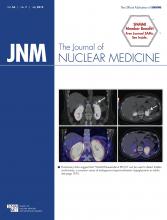PET and aortic aneurysm: Rudd and colleagues provide an overview of PET in aortic aneurysm, with a focus on the ability of imaging to predict expansion, and preview a related article in this issue of JNM.
Page 971
Calcium in noncalcified lesions: Strauss and Narula look at the pathophysiology of atheroma, the clinical significance of intimal arterial calcification, and an article in this issue of JNM on serial 18F-NaF vascular imaging in this setting.
Page 974
Retention of 177Lu/177mLu-DOTATATE: Sjögreen Gleisner and colleagues investigate long-term activity retention of radionuclides from peptide receptor therapy dosimetry and discuss the implications for timing of postdosimetry imaging.
Page 976
Quantifying SPECT uptake: Rowe and colleagues report on the variability of normal abdominal organ uptake values in serial 111In-pentetreotide SPECT studies in patients with neuroendocrine or carcinoid tumors.
Page 985
PET/CT follow-up in colorectal cancer: Marcus and colleagues explore the added value of a fourth and subsequent follow-up PET/CT scans in clinical assessment and patient management after primary treatment for colorectal cancer.
Page 989
PET vs. PET/CT in esophageal cancer: Goense and colleagues provide a metaanalysis of the performance of 18F-FDG PET and integrated 18F-FDG PET/CT in diagnosing recurrent esophageal cancer after initial treatment with curative intent.
Page 995
18F-DCFBC PET in primary prostate cancer: Rowe and colleagues evaluate PET imaging with this prostate-specific membrane antigen–targeting tracer in men undergoing definitive surgery and correlate results with those from pelvic MR imaging and pathology.
Page 1003
Mortality prediction in heart failure: Narula and colleagues apply multiple multivariate risk modeling techniques to determine the independent prognostic ability of 123I-MIBG imaging for mortality outcomes in individuals with heart failure.
Page 1011
NaF uptake in atherosclerotic plaque: Fiz and colleagues use PET/CT to look at vascular 18F-NaF uptake in plaque of 3 different densities and discuss possibilities for molecular assessment of calcium deposition in early stages of plaque formation.
Page 1019
Therapy control in graft infections: Husmann and colleagues report on the clinical value of 18F-FDG PET/CT for therapy control and management in patients with prosthetic vascular graft infections.
Page 1024
PET/CT in AAA: Morel and colleagues describe the results of an analysis of serial 18F-FDG PET imaging of rates of growth in medically treated abdominal aortic aneurysms and of metabolic parameters of associated parietal inflammation.
Page 1030
Midbrain function in PD: Joutsa and colleagues use 123I-FP-CIT SPECT to elucidate midbrain dopaminergic projections and extrastriatal serotonergic abnormalities in patients with Parkinson disease.
Page 1036
Voxelwise parameter correlations and Aβ load: Sojkova and colleagues use 15O-H2O and 11C-PiB PET to research local relationships between distribution volume ratio, cerebral blood flow, and amyloid-β load in nondemented older adults.
Page 1042
Quantifying inflammation in neurodegeneration: Lavisse and colleagues assess 18F-DPA-714 PET in healthy translocator protein–genotyped volunteers and explore a method designed to eliminate the need for invasive arterial blood sampling.
Page 1048
Enhancing T cell imaging sensitivity: Moroz and colleagues focus on human reporter gene systems and the minimum numbers of T cells that can be visualized with different nuclear reporter systems and PET or SPECT imaging.
Page 1055
MR AC in PET/MR: Paulus and colleagues detail a novel model-based attenuation correction method that improves PET quantification of bone and nearby soft tissue in whole-body hybrid PET/MR imaging.
Page 1061
Pediatric PET/MR AC: Bezrukov and colleagues assess the impact of 2 potentially influential factors—inter- and intrapatient variability of attenuation coefficients and anatomic variability—in PET/MR imaging in children.
Page 1067
GLP-1 receptor PET/CT: Antwi and colleagues determine whether PET/CT imaging with a novel 68Ga-labeled glucagonlike peptide-1 receptor–targeting agent is feasible and sensitive in detecting benign insulinomas and compare results with those from 111In-DOTA-exendin-4 SPECT/CT.
Page 1075
Current developments in radioembolization: Braat and colleagues provide an educational overview of indications and approaches in radioembolization, with a focus on patient selection, recent developments, and future applications.
Page 1079
64Cu-FBP8 and DVT-PE imaging: Blasi and colleagues explore the feasibility of 64Cu-FBP8 PET for detecting source thrombi and culprit emboli after deep vein thrombosis and pulmonary embolism and offer human dosimetry estimations.
Page 1088
Anti-PSMA Nanobody: Chatalic and colleagues describe the development of initial studies with a novel anti–prostate-specific membrane antigen Nanobody for targeted SPECT/CT imaging and therapy of prostate cancer.
Page 1094
Kit-producible 18F-SiFAlin: Niedermoser and colleagues research the in vivo properties of good manufacturing practice–compliant and “kitlike producible” 18F-SiFA– and 18F-SiFAlin–modified TATE derivatives for PET imaging in somatostatin receptor–bearing tumors.
Page 1100
Liposomal therapy and 18F-FDG PET: Hwang and colleagues assess delivery of angiogenic peptides with vascular endothelial growth factor in cerebral ischemia and explore the potential of 18F-FDG PET imaging in an animal model of ischemic stroke treatment.
Page 1106
Monitoring oncogene expression: Mendler and colleagues report on a comparison of 89Zr and 124I in labeling of the recombinant αHER2 Fab-PAS200 protein tracer for immuno-PET imaging of HER2-positive human xenograft tumors in mice.
Page 1112
Targeted radionuclide therapy workshop: Fahey and colleagues summarize the proceedings of a second joint SNMMI/National Cancer Institute expert meeting on current developments and future potential for targeted radionuclide therapy, held in October 2014.
Page 1119
- © 2015 by the Society of Nuclear Medicine and Molecular Imaging, Inc.







